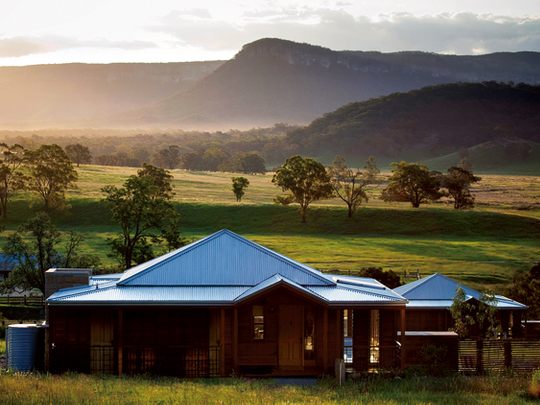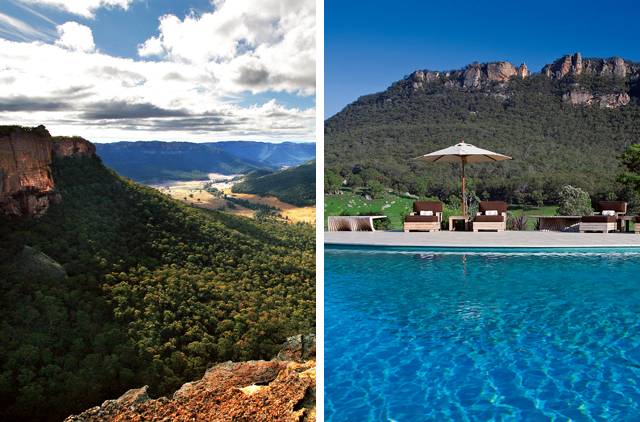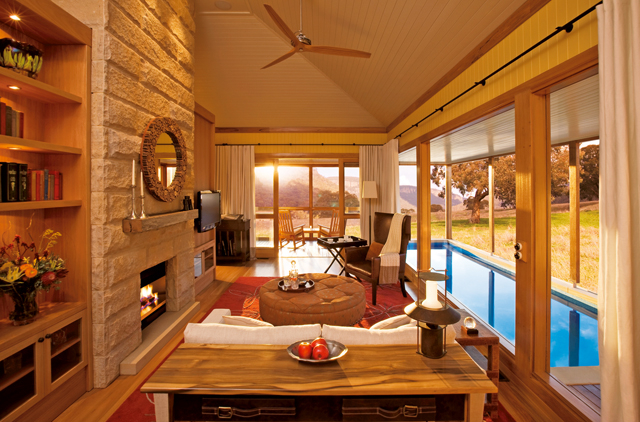
It was a scene more reminiscent of a Bond movie than the beginning of a luxury conservation holiday. Half way up Australia’s Blue Mountains, inching our way around a blind hair-pin bend with barely enough room for one car, we were confronted by a jeep coming in the opposite direction. Cue a slow, vertiginous mechanical tango, with a sheer drop just millimetres from my window to add an extra back-wheel-spinning kick to the drama.
Leaning to the left, my way of making sure we didn’t tip over the edge as we hugged the corner, I eventually saw an expanse of tarmac wide enough for two, and took a breath. That was the moment I’d dreaded since starting the cork-screw drive up the mountain. But savouring safety, I suddenly didn’t mind that I’d lost my mobile phone signal, the radio had gone silent and that huge, hairy Huntsman spiders and poisonous snakes potentially awaited me.
I was dizzy with adrenalin and more than ready for ‘The Wild’. OK, I wasn’t exactly going to rough it, having been booked into Emirates’ AuS$125 million Wolgan Valley Resort & Spa, a carbon-neutral, luxury resort. Bursting with eco credentials – it’s been certified through an accredited greenhouse gas programme – it collects rainwater, uses solar panels for heat, and is home to the Wollemi Pine, which dates back 200 million years.
This is a botanical biggie – it was growing at Wolgan before dinosaurs even roamed the earth, and is the plant equivalent of finding a live pterodactyl in the grounds. No wonder the resort picked up the Conservation Award at the World Travel and Tourism Council’s 2010 Global Summit. But did I mention that it costs up to AuS $5,500 per night (Dh21,074) and that I was staying for two? Nestled between the Wollemi and the Garden of Stone National Parks, Wolgan Valley borders the Greater Blue Mountain World Heritage Area and is a three-hour (sometimes goose-bump inducing) drive from Sydney.
It can’t be reached by sleek cars though, no matter how good they are around mountain bends. It’s a job for a sturdy 4x4, which can bounce over the dried, rut-ridden dirt tracks, and splash through the swollen rivers and creeks. For those with a fatter wallet than mine, there’s always the helicopter option, but what better way to reach this modern take on an Aussie cattle station than in an open jeep, leaving giant dust clouds in our wake?
In Darwin’s footsteps
After all the adventure, and bone-shaking rides, we eventually turned a corner and there it was in all its glory – the resort nestled in the valley against a Constable-esque backdrop of orange sandstone cliffs and green forests blanketing the mountains. The people at Emirates built Wolgan Valley after buying it from a family who farmed it, to do their bit for the environment. They kept the original homestead, now called 1832 after the year it was built, and carefully created the resort to blend into the 4,000 acres of private conservation and wildlife reserve.
It comes with an impressive guest list: Charles Darwin visited the valley in 1836 and stayed at the homestead, the media Packer family are said to be huge fans, and actress Mischa Barton rocked up there recently, adding some Hollywood glamour to the wilderness. She probably stayed in the ultra-deluxe Wolgan or Wollemi suites, but I was in the ‘standard’ five-star Heritage suite. Although there was nothing standard about it. Every one of the 40 individual suites has its own plunge pool, rain shower, dressing room, four-poster bed, verandah, sundeck, and double-sided fireplace.
Even though there’s no mobile signal at the resort – which was OK by me – there were electronic gadgets galore in my suite and a giant LCD TV hidden behind a painting, with another one at the foot of the bed. There were even free movies included, the same ones that Emirates offers on its flights. So after a dip in the plunge pool, I took the bike that comes with every suite for a (very wobbly) spin. It was a great way to explore. There is a contemporary Homestead, which contains the dining room, check-in desk, local art, and a giant clock made out of the trunk of a 650-year-old tree, along with a big, shared pool, and the Country Kitchen – an organic ‘casual’ eaterie.
In case guests aren’t relaxed enough by the scenery and solitude, there’s a spa and for the more adventurous, a smorgasbord of daily activities. I signed up for my first – the Wolgan Wildlife Tour. Clasping the binoculars from my room – they really have thought of everything here – I clambered back into another 4x4 with the field guide and a honeymooning Australian couple, and went out in the hope of glimpsing the Wolgan Big Four – kangaroos, wallaroos, wombats and wallabies. It didn’t take long to come face to face with them all.
My favourites were the kangaroos, their joeys hanging out of their pouches, and in some cases even popping out for a little walkabout, with their big eyes shining as the sun began to set, a giant pink ball disappearing behind the imposing cliffs. All that wildlife watching had made my stomach rumble so it was off to the Homestead for a five-course tasting menu of organic and locally sourced ‘tucker’. It was fine-dining at its best, and as the temperature had dropped, I sat by the log fire and looked out across the inky sky and valley, the only lights those coming from the suites and a corporate party being held in 1832.
Then it was an early night as I wanted to be up bright and early for my spa treatment – an amazing Hawaiian massage, which used sweeping motions and soon had me nodding off. Next was more tricky – should I go on a mountain bike ride, nature walk, Indigenous heritage tour, have a painting or photography lesson or take a guided four-wheel drive? In the end, I decided to do what anyone at an Australian cattle station should do – get on my horse! I haven’t been horse-riding since I was a child, but it really is like a bike – you never forget.
Sitting on top of the 15-hand black stallion I felt like Nicole Kidman in Baz Luhrmann’s epic, Australia, only without the hat. Mischa Barton remembered to wear hers, but then she probably had a stylist and wardrobe assistant with her. Having reacquainted myself with the equestrian world, I decided to tour the Valley in a horse and cart. Sitting behind a field guide and the driver I tuned into their fantastic Aussie accents, while taking in the magnificent scenery.
The cliffs dwarfed us, and winding round the plateau I learnt why the Blue Mountains are called that even though they’re green. It’s one of nature’s magic tricks – the eucalyptus trees produce an oil that refracts in the sunlight, making them appear blue. I could have stared at them all day, but just over an hour later, the horses were pulling us back to the stables, their work over, and I headed back to my suite. I was alone here but I certainly wasn’t lonely. There was so much to do, see and eat. I revelled in my own company, and the silence and beauty of the wilderness.
Getting the star treatment
I was sad to be leaving the next day until I remembered I was swapping country luxury for city glamour. Instead of kangaroos I was staring at the iconic Sydney Opera House and Harbour Bridge, and staying at The Darling at Darling Harbour. Part of The Star complex, my hotel was chic, cool and home to George Clooney, Leonardo di Caprio and Al Pacino when they were last in town. George’s suite came with his own personal entertainment room to delight his guests. I made my own entertainment jumping on the enormous bed, and deciding whether to eat Japanese or Italian.
I went oriental in the end, marvelling at the tiny grilled sweetcorn and vegetarian sushi. The Darling is the perfect place from which to explore the city, but it is also a resort in its own right. With six international restaurants, a casino complete with bow-tied croupiers, eight bars, a spa, health club, and the Sydney Lyric Theatre – which has played host to Elton John, Stevie Wonder and Bon Jovi – you need extra-strong willpower to venture outside.
But I made the most of my 24 hours in Sydney, even managing to catch up with a long lost friend who now lives there, and eating at the amazing Sydney Café, overlooking the harbour. Then it was time to leave the wild, and the excitement of Australia. But as the Aboriginal proverb says: ‘We are all visitors to this time, this place. We are just passing through. Our purpose here is to observe, to learn, to grow, to love... and then we return home.’













